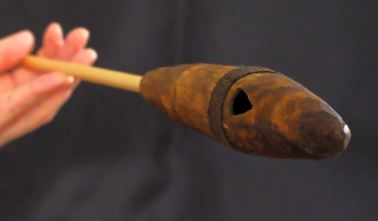
|
|
Humming Bulb Arrow (signal arrow)
Published June 4, 2020

Fragmentary materials found on prehistoric sites tell us something about ancient man in the Ryukyu archipelago. Chipped arrowheads, harpoon points made out of wild boar bone, chipped and poliched stone implements such as axes, hoes, hammers) and shell ornaments are found in the shell mounds and kitchen middens. Simple decorations applied to crude pottery suggest that the early settlers in these islands attempted to gratify a primitive aesthetic sense. The bones of dogs, deer, and swine suggest something of the economy. Human skeletal remains are rare and incomplete. Most perishable articles of wood, fiber or bone have long since mouldered away. Archaeologists have made a preliminary study of some of these remains. Dr. Kanaseki Takeo suggests that "the last stage of the Stone Age in Yaeyama was in the early Ming dynasty" or not much before the 14th century. He finds no basis in physical anthropology to support belief in the presence of Ainu elements among the Okinawan people, but on the basis of cultural anthropology he suggests that successive waves of migration from the south worked some modification upon the Jamon culture met with in Okinawa and the islands further north. There is evidence of a prehistoric "Yaeyama culture" having strong affinities with the south, with Indonesian and Melanesian cultures. Certain forms of agriculture and fisheries and the use of composite "plank-built" boat have been identified. On Ishigaki and Taketomi islands in the Yaeyama group such cultural remains are overlaid by strata containing fragments of early Ming pottery. Superimposed on all of this are the complex culture-forms which penetrated these islands from Japan and later, in historic times, from China by way of Okinawa. On Okinawa and the islands to the north the ancient "Yaeyama-type" remains are overlaid and intermingled with the remains of Jomon cultures carried down from Japan proper. Physical characteristics of the Ryukyuans show that they belong to a group which may be called "South Kyushu and Ryukyuan" peoples. Language forms throughout the archipelago show close alliance with the early language of the Japanese islands, and there have been authoritative suggestions that the intonations with which the Japanese dialects are used "seem to bear resemblance to that of the Indonesian languages." In other words, cultural elements penetrated the islands from both the south and the north, overlapping and reacting upon one another. Dr. Kanaseki suggests that the interchange of language and culture was more far-reaching than the interchange or blending of race and physical types, and that "in some features and in some districts the cultural interchange has not been completed yet." Contemporary Okinawans preserve many visible links with the past - legends, artifacts, and folkways - which have not yet been wholly submerged by importations from the continent (or from the West) in historic times. The so-called "curved jewels" or comma-shaped stones (magatama) used by village priestesses provide a good example. In Korea and Japan they are found in archaeological sites associated with the Late Neolithic and the Bronze ages, that age of the great burial mounds; they form the sacred jewels of the imperial Japanese regalia, but are never seen in daily use. The curiously shaped humming bulb arrow (or whistling arrow, or signal arrow) of early continental origin, made with wood or deer horn, may be seen in Japan in only a few museums. Originally used for hunting, they came in the Heian period to be used to signal the beginning of a battle. In Okinawa it still has ceremonial use (in replica) on numerous occasions such as the dedication of a new house or the festival launching of a canoe, and in village holiday processions. |
How a humming bulb arrow is made
Sources: |
©2020 Contact: ClickOkinawa.com
